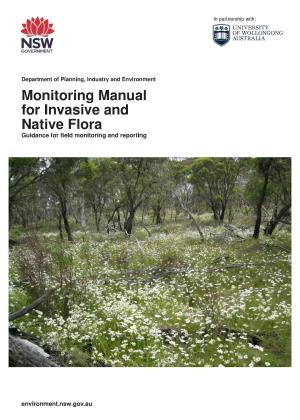Monitoring is critical to understanding what causes population change, testing appropriate management techniques and effectiveness, and for conveying robust and appropriate information about species and communities. Monitoring allows us to examine if our management is achieving the desired outcome or if we need to make changes. It provides an opportunity to change our management to improve biodiversity outcomes.
The Monitoring Manual for Invasive and Native Flora: Guidance for field monitoring and reporting (PDF 7.3MB) is based on the previous Monitoring Manual for Bitou Bush Control and Native Plant Recovery, other texts, previous monitoring programs, and the authors’ knowledge of ecological monitoring techniques. This manual can be used to monitor the response of invasive weeds, native plants and ecological communities before, during and after weed control programs.
Why monitoring is important
Monitoring is often seen as resource intensive and an expensive (or unnecessary) part of land management work. Particularly within the weed management field, it can often be seen as diverting resources from the control effort. But if the responses of weeds, native plants and communities to management actions are not monitored, nothing can be learnt about the effectiveness of the actions or whether other management actions are needed. This is the underlying reason for all monitoring: to ensure that your actions are achieving the intended outcome. A further benefit is that the monitoring results can be used to promote the success of your weed management and affirm positive biodiversity outcomes that may be obvious to the land manager over time.
How this manual helps you
This manual should be used to design your own monitoring plan, relative to your monitoring question, expertise, resources and the timeframe over which you’ll be able to see the results of your control program. With a specific monitoring program, you will be able to adapt your control program to be most effective for your desired outcomes.
Structure of this manual
The techniques in this manual range from simple qualitative assessments for preliminary observations to more in depth, robust monitoring methods to demonstrate outcomes. This allows land managers to adopt the best techniques for their objectives, outcomes, skills and resources. We have developed a two-tiered approach to monitoring, reflected in this manual as chapter one, ‘Preliminary observations’, and chapter two, ‘Advanced outcomes’.
The second chapter builds on the first in the level of skills and resources needed, and in the complexity of the monitoring question they are designed to address.
Field datasheets
Field datasheets were developed for the manual and can be downloaded in PDF format below. The datasheets are also in the appendix of the manual.
Preliminary observations (chapter 1):
- Observational Monitoring Field Datasheet (PDF 241KB)
- Photopoint Monitoring Field Datasheet (PDF 122KB)
Advanced outcomes (chapter 2):


